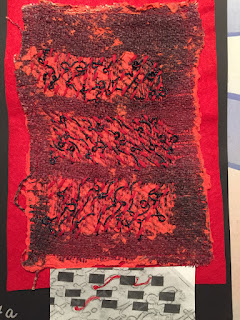sample 9a:red chenille yarn was wrapped around the edges, because of the irregularity of these, the stitching becomes irregular too
sample 9b: here the edges were first wrapped with a fabric strip from the fabrics from this module. This was stitched in place with a straight stitch. Then the edges were decorated with beads
sample c: edges decorated with free motion circular stitching, the paper is backed with red fabric
sample d: a normal office paper punch wasused to make the holes into the paper. Then a cord made of perle coton was wrapped around the edges. A bigger cord is then threaded through. The bottom edge is fringed
sample e: these edges were wrapped with a blanket stitch before the red yarn was threaded through
sample f: the edges of this samples have been decorated in various ways. The pins in the bottom line come from a new man's shirt and embroidery thread was wrapped around them.
Both the bottom and the left edge are backed with red commercial felt to hide and secure the pins.
Paper clips are decorating the upper edge of the paper and are fastened with a zigzag stitch. A red (polyester) ribbon is woven through the paper clips and secured with a zigzag stitch.
---------------------------------------------------------
Some of the samples have to be backed with fabric,As this is seen when the papers are used in a book, a solution has to be found to form a nice finish. The fabric could be decorated with additional stichting before being added to the paper.





























